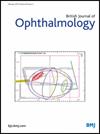丹麦近视儿童0.01%和0.1%负荷剂量阿托品治疗包括洗脱期的3年结果:一项安慰剂对照随机临床试验
IF 3.7
2区 医学
Q1 OPHTHALMOLOGY
引用次数: 0
摘要
目的探讨低剂量阿托品(0.01%和0.1%负荷剂量)治疗6 ~ 12岁丹麦近视儿童2年及1年洗脱期后的安全性和有效性。方法研究者发起、安慰剂对照、双盲、随机临床试验。在124名筛选的儿童中,97名随机分组,接受0.01%低剂量阿托品治疗24个月(0.01%)或0.1%低剂量阿托品治疗6个月,然后接受0.01%低剂量阿托品治疗18个月(0.1%负荷剂量)或安慰剂,随后进行1年的洗脱期。总共有91名参与者完成了这项研究。主要结果是近视进展(眼轴长度(AL)和球面等效屈光度(SER))。次要结局是不良事件、眼部生物测量和治疗反应眼(近视进展小于- 0.50屈光度(D))。根据意向治疗,构建了参与者ID嵌套个体眼睛的约束线性混合模型。应答者分析使用Fisher的精确检验。对多重比较的显著性水平进行了调整。调整后的p值<0.05为显著性。结果3年时,平均AL为- 0.06 mm (95% CI - 0.18;0.07)和- 0.09 mm (95% CI - 0.21;0.04),与安慰剂相比,0.1%负荷剂量组和0.01%负荷剂量组减少。平均SER为- 0.02 D (95% CI - 0.30;0.26)和0.17 D (95% CI - 0.11;0.1%负荷剂量组和0.01%负荷剂量组与安慰剂组相比增加0.45)。在反应眼上没有显著的组间差异。结论洗脱后两组患者近视进展无差异。与0.01%负荷剂量相比,6个月0.1%负荷剂量没有提高疗效。0.1%的负荷剂量在剂量转换后表现出反弹效应。如有合理要求,可提供资料。如通讯作者提出合理要求,可提供数据。本文章由计算机程序翻译,如有差异,请以英文原文为准。
3-year results of 0.01% and 0.1% loading dose atropine treatment including washout in Danish children with myopia: a placebo-controlled, randomised clinical trial
Aim To examine the safety and efficacy of low-dose atropine (0.01% and 0.1% loading dose) after 2-year treatment and 1-year washout in 6-year-old to 12-year-old Danish children with myopia. Methods Investigator-initiated, placebo-controlled, double-blind, randomised clinical trial. Of 124 screened children, 97 were randomised to receive 0.01% low-dose atropine for 24 months (0.01%) or 0.1% low-dose atropine for 6 months, then 0.01% for 18 months (0.1% loading dose) or placebo, followed by a 1-year washout. Altogether, 91 participants completed the study. The primary outcome was myopia progression (axial length (AL) and spherical equivalent refraction (SER)). Secondary outcomes were adverse events, ocular biometrical measurements and treatment responder eyes (myopia progression less than −0.50 diopters (D)). Constrained linear mixed models were constructed with individual eyes nested by participant ID, according to intention-to-treat. The responder analysis used Fisher’s exact test. Significance levels were adjusted for multiple comparisons. Adjusted p values <0.05 were considered significant. Results At 3 years, the mean AL was −0.06 mm (95% CI −0.18; 0.07) and −0.09 mm (95% CI −0.21; 0.04) less compared with placebo in the 0.1% loading dose group and 0.01% group. Mean SER was −0.02 D (95% CI −0.30; 0.26) less and 0.17 D (95% CI −0.11; 0.45) more compared with placebo in the 0.1% loading dose group and 0.01% group. There was no significant group difference in the responder eyes. Conclusion There was no difference in myopia progression between groups following washout. A 6-month 0.1% loading dose did not improve efficacy compared with 0.01%. The 0.1% loading dose showed a rebound effect after dose switching. Data are available upon reasonable request. Data is available upon reasonable request from the corresponding author.
求助全文
通过发布文献求助,成功后即可免费获取论文全文。
去求助
来源期刊
CiteScore
10.30
自引率
2.40%
发文量
213
审稿时长
3-6 weeks
期刊介绍:
The British Journal of Ophthalmology (BJO) is an international peer-reviewed journal for ophthalmologists and visual science specialists. BJO publishes clinical investigations, clinical observations, and clinically relevant laboratory investigations related to ophthalmology. It also provides major reviews and also publishes manuscripts covering regional issues in a global context.

 求助内容:
求助内容: 应助结果提醒方式:
应助结果提醒方式:


